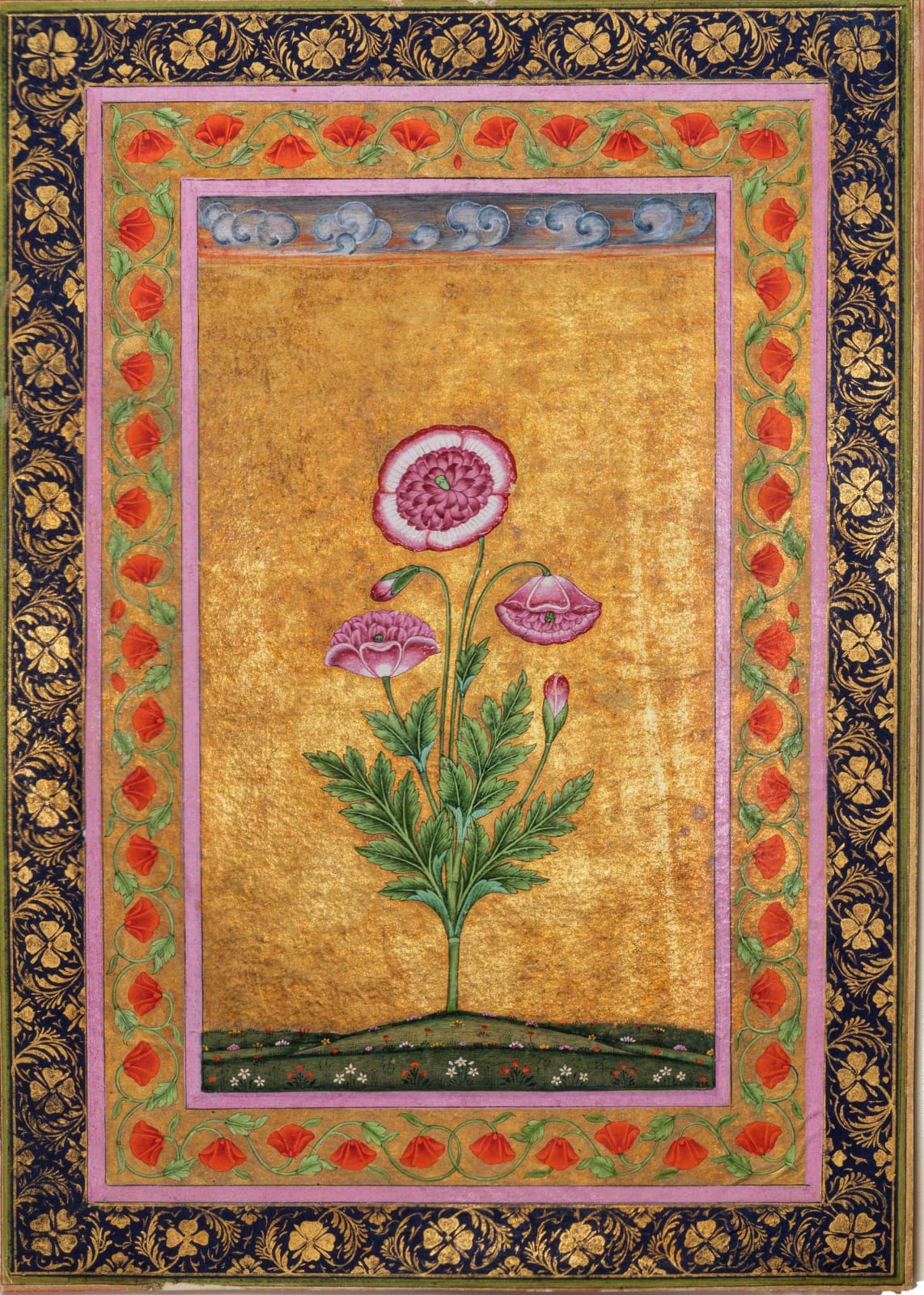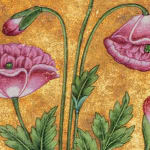Poppy on a gold ground
Folio 25.6 x 18 cm; painting 18 x 10.1 cm
Opaque pigments and gold on paper
Images of individual flowering plants came into vogue in Mughal art about 1620 in response to European examples introduced at court during the reign of Jahangir (1605-27), who directed Mansur, an artist best-known for his natural history paintings, to execute more than a hundred such paintings in Kashmir.[1] This genre flourished in the ensuing decade, most notably under the auspices of Prince Dara Shikoh (1615-59) in an album prepared for his beloved, and then more expansively in many media under Emperor Shahjahan (r. 1627-58). Although the meticulous detail of these flower paintings would logically seem to spring from a newfound penchant for empirical observation, the quasi-scientific quality of these botanical specimens is actually more informed by reference to European engravings. Flower paintings of this period customarily present the blossoms at different angles and at various stages of florescence simultaneously, deliberately depicting both bud and blossom to suggest the growth cycle. Typically isolated against an abstract background, the plants were also removed from any sort of natural environment, a conceit that insistently kept the focus on the structure and colour of the flowering plant itself. In some cases, a small bird or a flitting butterfly or other insect was introduced into the upper parts of the composition, a device likewise derived from Netherlandish art and enlisted to inject a measure of liveliness.
A variant of this botanical painting tradition took shape at the courts at Bijapur and Golkonda from the mid 17th century, as well as at the Rajasthani state of Kishangarh in the early 18th century. Scholars struggle to distinguish Mughal and Deccani examples of botanical painting from one another and to work out their chronology with any degree of certainty. Deccani examples, however, characteristically dwell on decorative aspects of the paintings, bringing out brighter and clearer ornamental qualities in the forms of the blossoms and leaves. In the Deccan, too, the background often changes from an unobtrusive unpainted colour to a solid gold, an enhancement that effectively thrusts the plant into relief and enriches the entire painting. Later examples also tend to shed the naturalistic and miniature elements embedded in the vegetation along the strip of landscape below.
The subject of this vibrant painting is an opium or breadseed poppy (Papaver somniferum). It is perhaps the most frequently depicted type of blossoming plant in Indian botanical painting, probably because the flower’s pharmaceutical and nutritional properties led to its widespread cultivation. The painting is dominated by the large open blossom, brilliant in all its mauve-and-white glory, and punctuated at its centre by a small and somewhat schematic capsule. Two more blossoms, one facing up, the other down, offer profile views of the mostly mauve flower, and are complemented by still more compact buds. The serrated and folded leaves are characteristically greyish-green in colour, a trait accentuated by the high contrast between the light undersides and veining and the dark central part. The stalk is rooted in a low, muted green mound with a simple network of ridges, and brightened with a smattering of tiny plants with pink and white blossoms sprouting up at regular intervals. The composition culminates in a discrete band of clouds, their curling grey-and-white forms assuming a similar regularity in form and placement.
Close inspection of the painting has revealed some unexpected physical anomalies. It appears to some observers that the flower has been painted over the thick reddish gold background, though the use of gold as a base colour poses a technical problem, for it readily leads to surface flaking. The painting is on the same paper support as the narrow pink borders and the scrolling border with the red poppy design. The outer border of gold on indigo has been added.
The work compares well to several other Deccani examples. One, a painting of a balsam plant assigned to the Deccan, c. 1660-80, possesses a similar ornamental quality in the plant and blossoms, a slightly more complicated groundline, and an analogous band of sky at the top.[2] Perhaps more telling is another painting of c. 1700 of a feathered poppy, this time set against a gold ground; a butterfly and insect appear above against a hint of a streaky sky, and the ground below is once again a schematic mound with mundane subdivisions and vegetation.[3] Intriguingly, that painting, whose leaves and overall effect are highly reminiscent of those of the present work, is signed in red on the painting by Muhammad Ibrahim, who identifies himself as a humble muzahhib (illuminator) of Mashhad. If this artist of Persian training were also responsible for the present work, as is possible, it would go a long way towards accounting for the high-key visual drama and formality of this Deccani manifestation of the floral tradition.
[1] For an overview of this artist and phenomenon, see A. Das, Wonders of Nature: Ustad Mansur at the Mughal Court (Mumbai, 2012), pp. 138-149.
[2] Philadelphia Museum of Art 2004-149-39, published in J. Seyller in D. Mason et al., Intimate Worlds: Indian Paintings from the Alvin O. Bellak Collection (Philadelphia, 2001), no. 41.
[3] Christie’s, London, 27 April 2023, lot 81.



